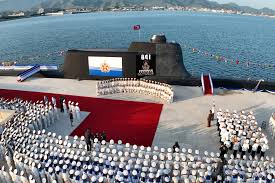US Military is Helping South Korea Build Nuclear Powered Subs
Aaron Stanway
International / US News Editor
The United States and South Korea have finalized an agreement that will allow Seoul to begin developing its first fleet of nuclear powered attack submarines. The vessels will not carry nuclear weapons. Instead they will use nuclear reactors for propulsion. This gives them the ability to stay underwater for long periods of time and track enemy submarines and warships with far greater stealth. Under the deal, the United States will provide technical guidance, reactor safety support and advanced training for South Korean naval crews. South Korea will build the submarines in its own shipyards. The first designs are expected to draw from both American and Korean technology. The goal is to create a fleet that can patrol the waters around the Korean Peninsula, the East China Sea and eventually the wider Indo Pacific.
Why the Two Countries Are Doing This
The main reason for the agreement is growing concern over North Korea. Pyongyang has been expanding its missile program at a rapid pace. It has conducted multiple tests of new submarine launched missiles. Nuclear powered submarines would allow South Korea to track these threats and respond more quickly. They also fit into Seoul’s long term plan to modernize its navy into a force that can operate far beyond its coastal waters. There is also a political dimension. Washington wants to reassure South Korea that it remains fully committed to their defense. By supporting this program, the United States signals that it views Seoul as a major strategic partner rather than a junior ally.
Why the Deal Matters
This agreement marks a significant shift in regional military balance. Nuclear powered submarines are one of the most difficult platforms to detect. Once South Korea fields them, it will possess a level of underwater capability that only a few countries have. This strengthens deterrence against North Korea while also giving Seoul more independence in its defense planning.
The deal also reflects a larger trend. Asian allies are preparing for a future in which threats are becoming more complex. Advanced submarines help counter missile launches, protect shipping routes and gather intelligence without revealing their position.
What It Means for US Power in the Region

For the United States, helping South Korea build these submarines reinforces its influence in Asia. China has been expanding its navy at a pace the world has never seen before. It is also increasing military pressure around Taiwan. A stronger South Korean fleet contributes to a network of capable partners who can monitor Chinese movements and coordinate with US forces.
The agreement also fits into Washington’s strategy to strengthen alliances rather than rely only on its own military presence. A South Korean submarine force that can operate quietly in the same contested waters as Chinese and Russian vessels gives the United States a major strategic advantage. It creates more eyes and more pressure points during any future crisis in the Taiwan Strait or the South China Sea.
In short, this deal is not only about submarines. It is about shaping the balance of power in a region where competition is rising quickly. More details will continue to emerge as the program develops.
Contact Aaron at Aaron.stanway@student.shu.edu

